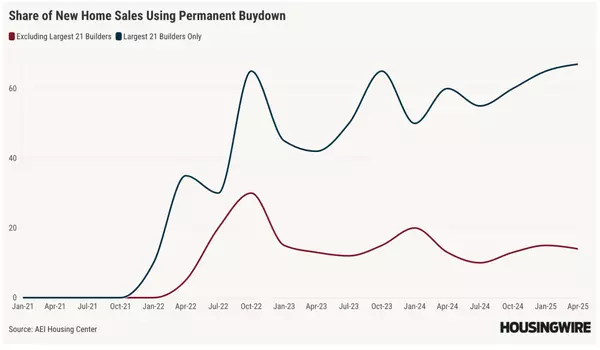Florida Realtors, Japan-America Real Estate Coalition expand ties

Florida Realtors has signed a memorandum of understanding with the Japan-America Real Estate Coalition Office (JARECO) — strengthening cooperation and expanding business opportunities between real estate professionals in Florida and Japan. Under the memorandum, Florida Realtors and JARECO will focus
Read MoreNorthstarMLS restructures board, embraces new governance model

Minnesota’s NorthstarMLS is shaking up its governance structure. In an announcement on Wednesday, the MLS said that its shareholder associations, which include Minneapolis Area Realtors (MAR), the Saint Paul Area Association of Realtors (SPAAR), and the Southeast Minnesota Realtors (SEMR), have made
Read MoreNewrez wholesale leader Tony Kottenbrock talks about growing non-QM

Non-QM production at multi-channel mortgage lender Newrez has surged 40% in recent months, with company leaders pointing to enhanced guidelines and growing demand for second mortgages as key drivers of record-breaking wholesale production. Coming off of the company’s Q3 2025 earnings report on Thurs
Read MoreRealtor.com releasing 3D “FlyAround” property viewing tool

Realtor.com plans to introduce a new 3D property viewing tool called FlyAround. The tool allows users to explore homes and neighborhoods through a low-altitude satellite view. The feature will begin rolling out in the coming weeks. FlyAround uses Google Maps’ 3D technology and is powered by TopHap I
Read MoreZillow’s Follow Up Boss privacy policy changes spark industry debate

Zillow Group is making changes to Follow Up Boss’s privacy policy and many in the real estate industry are taking issue with the changes. Earlier this month, Zillow informed users of Follow Up Boss, which it acquired in 2023, that a new privacy policy is set to go into effect on November 15, 2025.
Read MoreTop California team joins Equity Union Real Estate

Equity Union Real Estate announced Thursday that Dennis and Yana Chernov, along with The Chernov Team, have joined the Los Angeles-based brokerage. The Chernov Team — known for its work in luxury real estate — specializes in new construction and residential sales, including traditional homes and con
Read MoreOcrolus adds automated conditioning to mortgage tools

Ocrolus, an AI-powered data and analytics platform for credit decisioning, recently announced it’s adding automated conditioning to its suite of products. The new solution allows mortgage lenders to move faster, increase loan quality and reduce compliance risk. The new capabilities, announced at the
Read MoreNRMLA pushes for Senate confirmation of Ginnie Mae’s Gormley, FHA’s Cassidy

The National Reverse Mortgage Lenders Association (NRMLA) and other trade groups issued statements of support this week as they seek to have the Senate confirm two key leaders to federal housing posts. The letters reference President Donald Trump’s nominations of Joseph Gormley as president of Ginni
Read MoreRE/MAX sees Q3 profit rise despite revenue dip, talks AI and franchise programs

RE/MAX Holdings reported a decline in third-quarter 2025 revenue compared with the same period a year earlier, but also saw a net income uptick. The parent company of RE/MAX and Motto Mortgage posted total revenue of $73.3 million, down 6.7% from the third quarter of 2024. Excluding marketing funds,
Read MoreAffordability for first-time homebuyers: Beyond rates and prices

We’ve all heard the refrain: it’s never been harder to buy your first home. The narrative almost always circles back to two usual suspects – mortgage rates and home prices. While rates and prices are undeniably visible and powerful levers, they are not the whole story. For industry insiders, the cha
Read MoreZillow focuses on consumers, agents to fuel future growth

It has been a messy few months for Zillow Group, including a copyright lawsuit from CoStar, a class action consumer RESPA suit, and antitrust suits from both Compass and the Federal Trade Commission (FTC). While some of the listing portal giant’s competitors have said that it is a company of the pas
Read MoreRocket’s integrations of Redfin, Mr. Cooper lift Q3 results above forecasts

Rocket Companies reported a third-quarter 2025 adjusted net income of $158 million on adjusted revenue of $1.78 billion, exceeding the high end of its guidance range, the Detroit-based mortgage lender said Thursday. On a GAAP basis, the company posted a net loss of $124 million on total revenue of $
Read MoreDebate heats up around GSEs’ potentially larger role as MBS buyers

Mortgage industry experts are divided over the idea of allowing Fannie Mae and Freddie Mac to increase their purchases of mortgage-backed securities (MBS) in order to reduce mortgage rates, a proposal recently suggested by trade groups. While the government-sponsored enterprises (GSEs) could create
Read MoreReal estate leaders praise federal housing action, stress first-time buyer help

For Keith Robinson, co-CEO of NextHome, the surge of federal attention on the housing shortage is a positive first step — but one that must be tempered by patience and practicality. “I’m ecstatic that it’s a conversation now, because that’s the first step,” Robinson said. “It’s gone from no one talk
Read MoreWhat changes are industry leaders demanding from NAR?

The National Association of Realtors (NAR) and its CEO Nykia Wright have broadly acknowledged that things within the trade organization need to change. And while the trade group and its leadership team have taken steps in that direction, meeting with members across the country and pushing for improv
Read MoreVRM executive Cheryl Travis-Johnson has died

Dr. Cheryl Travis-Johnson, the executive vice president and chief operating officer of VRM Mortgage Services, died last week, according to the company. Travis-Johnson, an industry veteran with over 30 years of service, joined VRM in 2008 and helped to position the company as a “trusted and innovativ
Read MoreGovernment shutdown impacts senior access to services

The federal government shutdown is set to reach one month on Saturday, and the impacts are being felt by many Americans, including seniors who are struggling to access food, health care and a variety of support services. An article published last week by national senior advocacy group AARP highlight
Read MoreChris Planto returns to Rate as VP of mortgage lending

Top-producing mortgage originator Chris Planto has rejoined Rate as vice president of mortgage lending in the Houston market. Planto returns to Rate from CrossCountry Mortgage, where he most recently served as a senior loan officer. “We are absolutely thrilled to welcome back Chris Planto to our Rat
Read MoreNewrez posts best monthly mortgage volume since 2022, seals Wells Fargo deal

Multichannel mortgage lender Newrez continued to contribute positively to parent company Rithm Capital’s earnings in the third quarter of 2025, during which the company closed an agreement with Wells Fargo in the private-label securities (PLS) space. In the third quarter, Newrez posted pretax income
Read MoreZillow Group Reports Third-Quarter 2025 Financial Results

Categories
Recent Posts










